Mooring Setup Information
| At MBBC, the club owns owns
and maintains everything up to and including the stainless
swivel on top of the hazelett, and the member owns and
maintains everything above that. Although the club owns the
swivel, for ease of installation and removal, keep the
swivel with your lines during the winter. For
standardization, the following should help you in the
seasonal installation and removal of your mooring lines. |
|
Click on photo to display full size.
|
Bumper Installation:
While not required, a rubber
bumper is strongly encouraged if you want to avoid hull
scrapes from the top of the hazelett. The "large" rubber
bumper available locally is designed to fit the "D"-type ears
shown in Figure #1. Simply drop the bumper over the ears
prior to installation of your pin and lines.
NOTICE:
There are two styles of hazelett moorings in our mooring
field. If your rubber bumper is the "large" type (8"
diameter) and your hazelett looks that in Figure #2 (the
rectangular ears are 5/16" closer to each other), you will need to modify
your bumper slightly. Simply remove an appropriate amount of
rubber material from each of the two slots. This is more
easily, neatly, and safely accomplished with a jig saw
rather than a knife! |
|
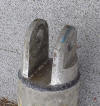 |
| Figure #1 |
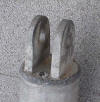 |
| Figure #2 |
Teflon Discs:
Two teflon disks are initially
provided to every member by the Harbor Committee. The disks prevent wear from
the stainless steel swivel on the inside of the hazelett ears, but only if they
are installed correctly! Figure #3 is an example of how NOT to install the
disks. Figure #4 is the correct method of installation, where the disks are
INSIDE the ears. Failure to have two teflon discs on the inside of the ears WILL
cause premature wear on the ears. This could weaken the hazelett and cause
failure of the hazelett and possible loss of your boat! Replacements may be purchased from Lakeshore Hardware or the HC
chairman for minimal cost.
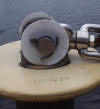 |
| Figure #3 |
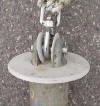 |
| Figure #4 |
|
Cotter Pins:
After installing the swivel
and stainless pin, members often bend the cotter pins more
than necessary. Bent or mangled cotter pins often make it
unpleasantly difficult for you to remove the cotter pin
before winter. Mangled pins also make it difficult for the
Harbor Committee members during maintenance. An example of
excessive bending is shown in Figure #3 above. The more
preferred method is illustrated in Figure #5 in which only
one leg of the cotter pin is bent, and then only far
enough to ensure the cotter pin won't fall out. It also
makes it easier for you to re-use in the Spring. It is
suggested by the HC that you bend one cotter pin as shown in
Figure #3. That cotter pin will be the one you will find
with the red identification tag on it (see Figure #9 below).
The other cotter pin that will be removed/installed on a
yearly basis should be bent as shown in Figure #5.
NOTICE:
Some members prefer to not row out to a slippery and wet
mooring on a blustery late October day, sharing an unstable
dinghy with wet mooring lines! Contact the Harbor Chairman
to have your lines removed and installed for a small fee.
Quiz: Although the cotter pin looks OK, what's wrong with
the installation in Figure #5? |
|
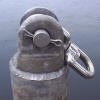 |
|
Figure #5 |
Mooring Line Recommendations:
For standardization and ease, the Harbor Committee recommends
the following:
- Decide whether you want one or two lines on your
hazelett.
- 3/4" three-strand line is the preferred maximum size
for the particular swivel we use, but line size may be
limited by the size of your bow cleats.
- Line length should allow approximately 6-8' between
hazelett and bow. During low-water conditions it may be
necessary to cleat your boat closer to maintain adequate
swinging room.
- While there is a rubber elastomer in the ground tackle
below the hazelett, the Harbor Committee recommends
adding another one on your line for added shock
absorption. (Members' boats that are in the 100' grid do
not need an additional elastomer.) Install the elastomer
within one foot of the hazelett to allow close cleating
when necessary.
|
|
One line: Have a 10" (inside) eye spliced into one end and
secure that eye to the swivel as shown in Figure #6.
 |
|
Figure #6 |
Two lines: Purchase a single line twice the desired length. Fold
it in half and secure the loop to the swivel as shown in Figure #6. An
alternative method of securing two lines is shown in Figure #7 but line
diameter must be smaller to fit the swivel.
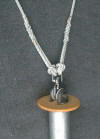 |
|
Figure #7 |
|
Cleating Recommendations: If you are an early season
sailor and there are no other boats secured to their
moorings in the immediate area where you boat is, it is
acceptable to have a longer pennant from your boat to
the hazelett. However, as the season progresses
and the lake level goes down and more boats fill in
around your mooring, it is suggested that you shorten
your pennant. The Harbor Committee recommends that you
adjust your pennant so that you have no more than 1'
PLUS the amount of freeboard at your bow, between your
bow cleat and the top of the hazelett. The purpose of
shortening your pennant is to reduce the swing radius of
your boat and to minimize the chance of your boat's
stern contacting another boat's stern in dead calm
conditions when the boats point every which way. If you
should happen to go out to your boat and notice that
your pennant has been shortened, please take note of how
it is tied and how much shorter it is tied off.
Repeat the process when you return from sailing. Doing
so will provide increased safety for your boat.
NOTICE:
A member should NOT connect the mooring line directly to
the hazelett without a stainless steel swivel. Doing so
could endanger your and other members' boats and could
(and does) damage various components of the ground
tackle beneath the hazelett. If you have misplaced the
stainless steel swivel please contact the Harbor
Chairman for a replacement.
Each autumn, by two weeks after club
closing all hazeletts need to be bare. During the winter
months, the hazelett must be completely bare of all
lines, swivels, rubber bumpers, gallon jug
marker bouys, etc. The exception to this is the two
teflon discs, pin, and the stainless steel donut (see
Figure #8 below). You can also expect the Harbor
Committee to facilitate that process, but it's your
responsibility to accomplish it. Anything left on after
that date will be removed by the Harbor Committee. |
Stainless Steel
Donut:
In an effort to reduce hazelett
damage in the off season, the HC is reintroducing the stainless steel 'donut'
as shown in Figure #8. The 'donut' weight is comparable to all the
hardware that the members put on the top of the hazelett in the summer. The
effect is that the hazelett will float as low in the off season as it does in
the summer, reducing the possibility of damage in the winter. This program
requires the club members participation to be successful.
When you remove your mooring lines and hardware in the Fall, follow these steps:
1. Remove the cotter pin from the large pin in the top of the hazelett and set
aside.
2. Pull the large pin out of the ears of the hazelett and set aside.
3. Remove both the teflon discs and the stainless steel swivel along with the
rubber bumper.
4. Reinstall the large pin in one ear of the hazelett.
5. Position the s/s 'donut' as shown with the teflon discs on each side
of the donut. Refer to Figure #9.
6. Push the large pin into the other ear of the hazelett and secure with the
cotter pin, bending it slightly. Refer to Figure #10.
In the Springtime, reverse the process and store the stainless steel 'donut' on
your boat so it is ready to use again in the Fall.
If you have ANY questions or if you should happen to drop the 'donut' overboard,
contact the Harbor Chairman for a replacement.
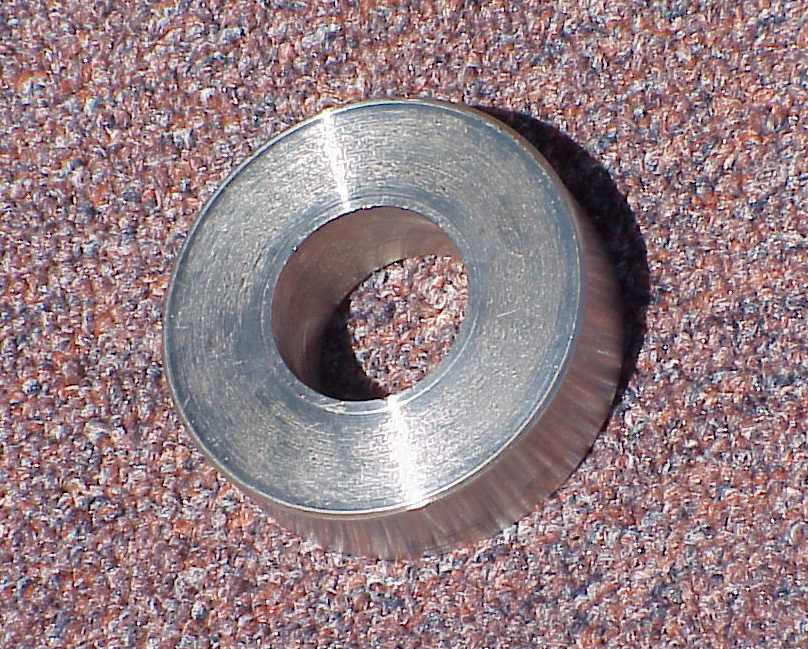 |
| Figure #8 |
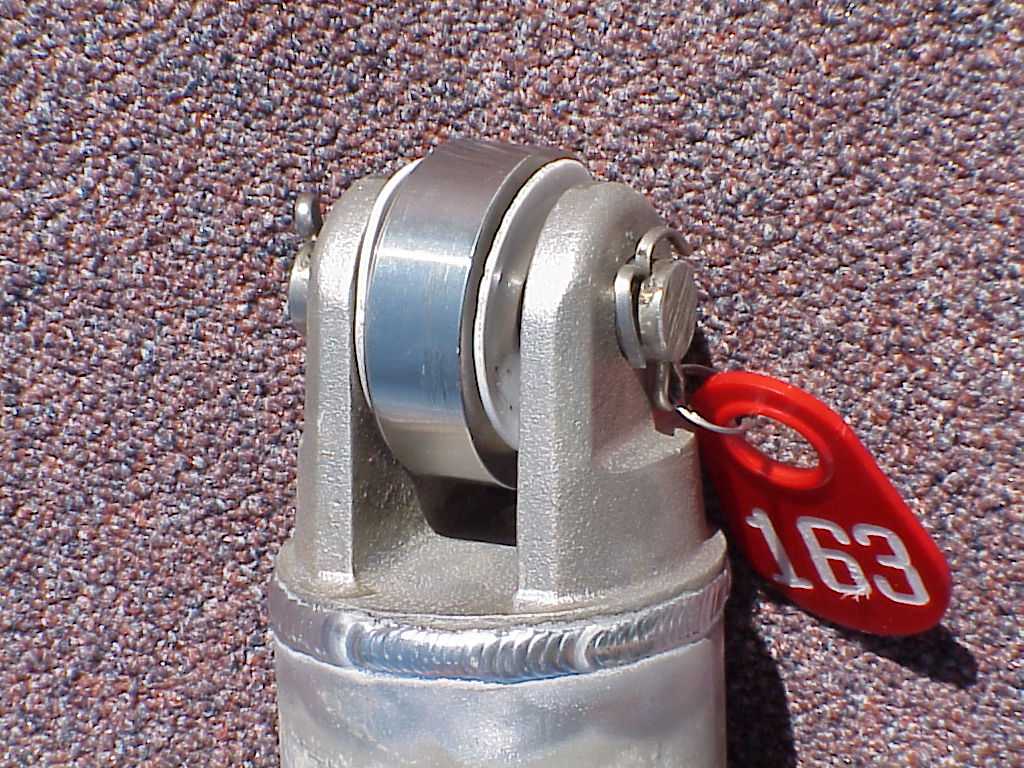 |
| Figure #9 |
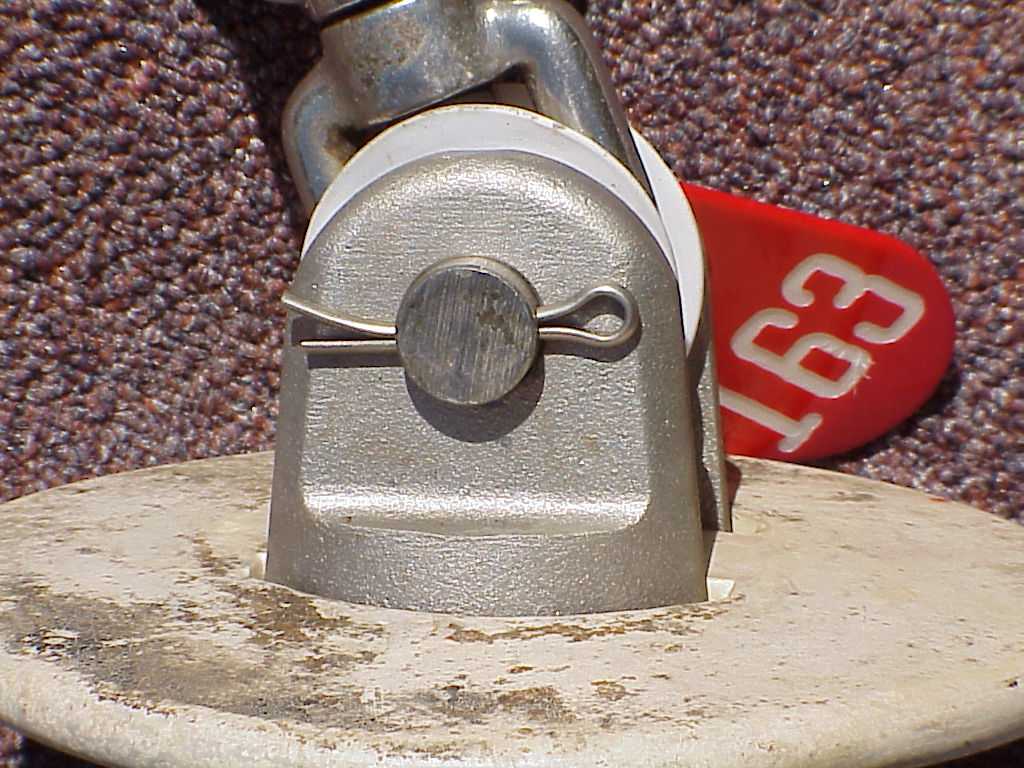 |
| Figure #10
|
|
|
 Back Home
Back Home









